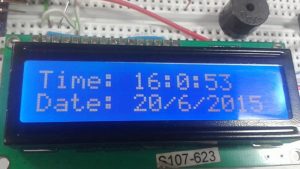This Arduino based Real time clock is a digital clock to display real time using a RTC IC DS1307 which works on I2C protocol. Real time clock means it runs even after power failure. When power is reconnected, it displays the real time irespective to the time and duration it was in off state. In this project we have used a 16×2 LCD module to display the time in – (hour, minute, seconds, date, month and year) format. An Alarm option is also added and we can set up the alarm time. Once alarm time it saved in internal EEPROM of arduino, it remains saved even after reset or electricity failure. Real time clocks are commonly used in our computers, houses, offices and electronics device for keeping them updated with real time.
I2C protocol is a method to connect two or more devices using two wires to a single system, and so this protocol is also called as two wire protocol. It can be used to communicate 127 devices to a single device or processor. Most of I2C devices run on100Khz frequency.
Steps for data writing master to slave (slave receiving mode)
- Sends START condition to slave.
- Sends slave address to slave.
- Send write bit (0) to slave.
- Received ACK bit from slave
- Sends words address to slave.
- Received ACK bit from slave
- Sends data to slave.
- Received ACK bit from slave.
- And last sends STOP condition to slave.
Steps for data reading from slave to master (slave transmitting mode)
- Sends START condition to slave.
- Sends slave address to slave.
- Send read bit (1) to slave.
- Received ACK bit from slave
- Received data from slave
- Received ACK bit from slave.
- Sends STOP condition to slave.
Circuit Diagram and Description
In this Arduino based digital clock circuit, we have used three major components which are IC DS1307, Arduino Pro Mini Board and 16×2 LCD module.
Here arduino is used for reading time from ds1307 and display it on 16×2 LCD. DS1307 sends time/date using 2 lines to arduino. A buzzer is also used for alarm indication, which beeps when alarm is activated. A block diagram is shown below to understand the working of this Real Time Clock.
As you can see in the circuit diagram, DS1307 chip pin SDA and SCL are connected to arduino pins SDA and SCL with pull up resistor that holds default value HIGH at data and clock lines. 32.768KHz crystal oscillator is connected with DS1307chip for generating exact 1 second delay, and a 3 volt battery is also connected to pin 3rd (BAT) of DS1307 which keeps time running after electricity failure.16×2 LCD is connected with arduino in 4-bit mode. Control pin RS, RW and En are directly connected to arduino pin 2, GND and 3. And data pin D0-D7 is connected to 4, 5, 6, 7 of arduino. A buzzer is connected with arduino pin number 13 through a NPN BC547 transistor having a 1 k resistor at its base.
Three buttons namely set, INC and Next are used for setting alarm to pin 12, 11 and 10 of arduino in active low mode. When we press set, alarm set mode activates and now we need to set alarm by using INC button and Next button is used for moving to digit. The complete breadboard setup of this real time clock with alarm is shown in below image. You can also check a detailed tutorial on digital alarm clock with AVR microcontroller.
Program Description
To program for this real time clock, we have used some libraries for extracting time/date from DS1307 and for displaying on LCD, which are given below:
And initialization of RTC, LCD and input output are performed in setup loop.
Read more: Arduino Based Digital Clock with Alarm


